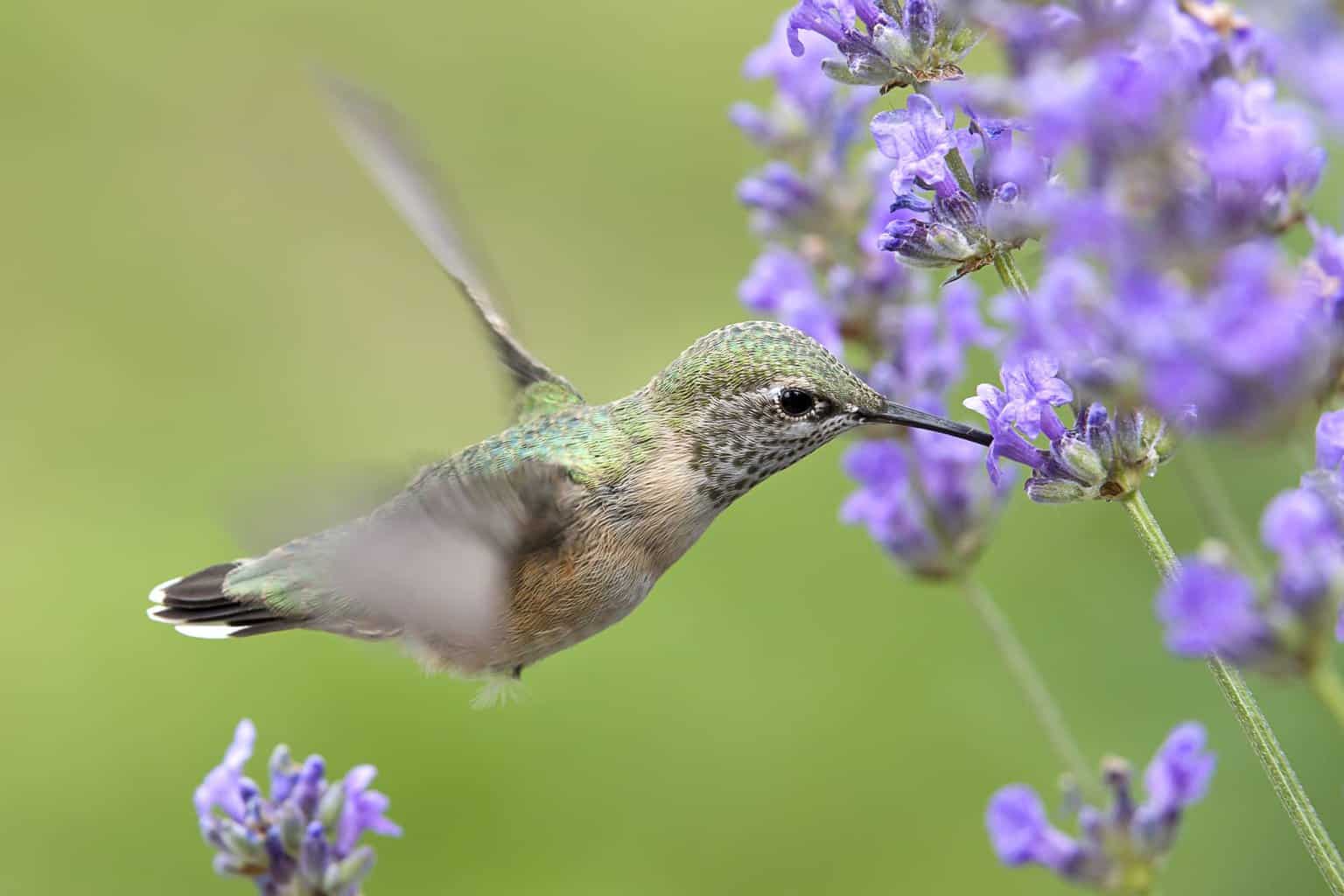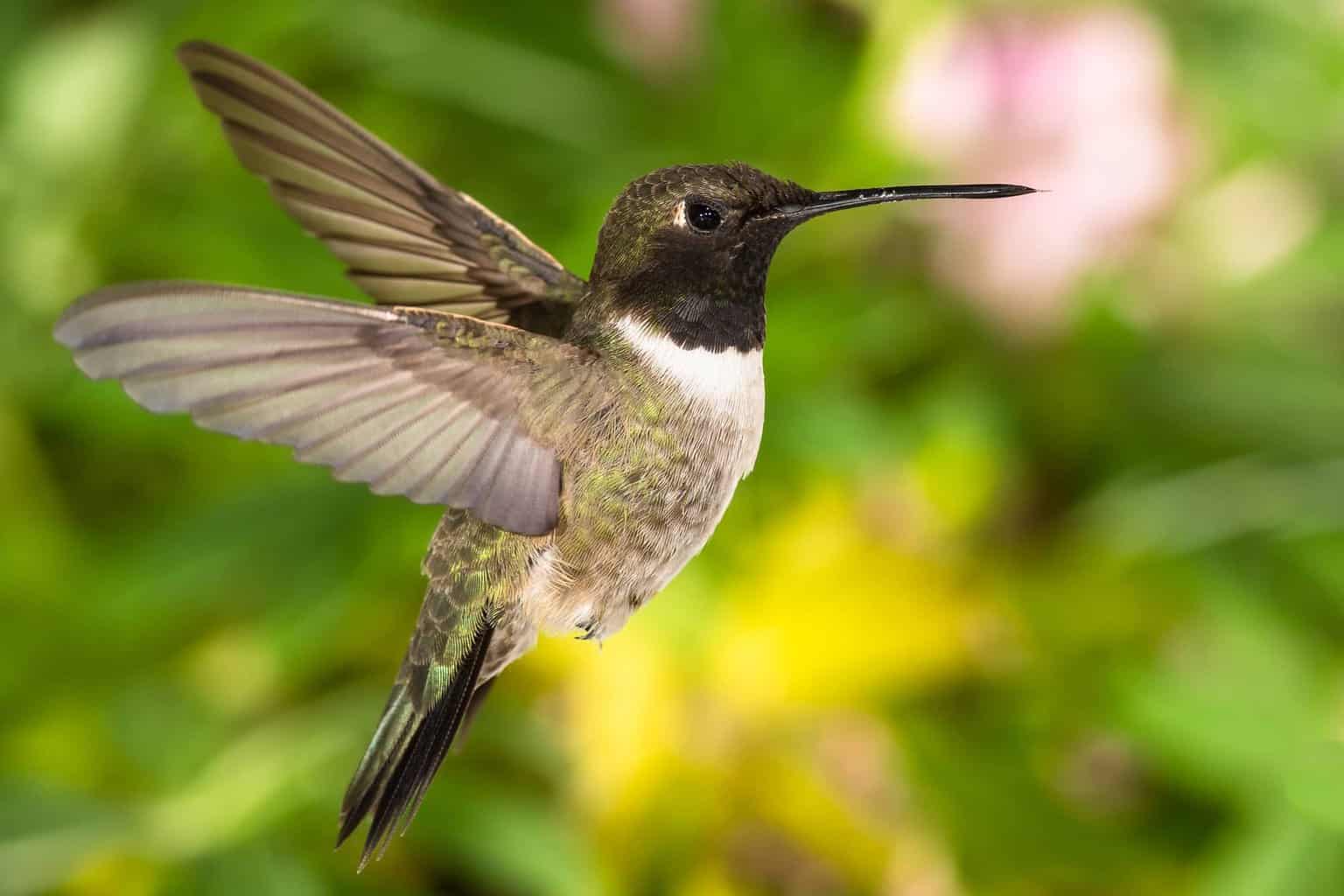Washington has two distinct climate zones: a rainy oceanic climate west of the Cascade Mountains and a dry Mediterranean climate east of the mountains.
Washington receives an average of 38 inches of rain and 18 inches of snow a year. Despite a reputation for being rainy, the coast also experiences more sunny days than many major cities.
The two distinct climates create distinct vegetation zones, with temperate rain forest along the Pacific coast of the state and desert and scrub in the western interior of the state.
Washington has a diversity of plant and animal species, including 520 bird species.
Of these species, only four hummingbird species commonly occur, namely Anna’s, rufous, calliope, and black-chinned. Anna’s is the only species in the state in winter.
Birdwatchers have observed several accident vagrants in the state.
Identifying Washington’s Hummingbirds And Additional Information About Them
Ornithologists classify hummingbirds into the family Trochilidae. This family occurs only in the Americas.
They are tiny birds and can not only hover, with their wings beating at such a high speed that they make a humming sound, they can also fly backward – the only birds that can do so.
They use these abilities to sip nectar from flowers, supplementing their diet with arthropods which they catch on the wing (hawking), take from leaves, or even take from spiderwebs.
They can burn both glucose and fructose. Other vertebrates cannot burn fructose.
We can classify the hummingbirds found in Washington as Frequently Found and Accidental Vagrants.
Hummingbirds Frequently Found In Washington
Four species of hummingbird are frequently found in Washington.
Anna’s Hummingbirds (Calypte anna)

- Length:9 inches
- Weight:1-0.2 ounces
- Wingspan:7 inches
Description:
Female hummingbirds and immature Anna’s hummingbirds are metallic green above, with grayish undersides and a few reddish-pink throat feathers.
Male Anna’s hummingbirds are mostly metallic green, with the green being darker on their backs. They have a metallic rose-pink throat and crown.
Additional Information:
Anna’s hummingbirds are found mainly along the Pacific coastline, from northern Mexico to southern Alaska. They are one of only three species that are permanent residents in the US or Canada.
They are the only hummingbirds to winter in northern climates, migrating from higher altitudes in the summer to lower altitudes in the winter.
They inhabit various habitats in their range, including streamsides, coastal sage scrub, chaparral, open woodlands, gardens, and parks.
Food sources for them include nectar and insects.
They are more vocal than most hummingbirds, with the males giving a buzzing song. They are a territorial aggressive species, as the males make elaborate dive displays at other birds and even people.
Rufous Hummingbirds (Selasphorus Rufus)

- Length:8-3.5 inches
- Weight:1-0.2 ounces
- Wingspan:3 inches
Description:
Female and immature rufous hummingbirds are greenish on their backs, heads, and wings, with rusty flanks and rusty patches on their green tails. Their chests are white.
Males have vivid coppery backs and bellies, an iridescent rusty-orange throat, green on their shoulders, and a white chest. The tail feathers come to a point when folded.
Additional Information:
Rufous hummingbirds utilize forest edges, streamsides, and mountain meadows for feeding.
They breed in forest edges, clearings, and brushy second growth in the west and northwest of North America.
They leave the western states in July and August, migrating through the Rocky Mountains to take advantage of wildflowers and winter in southern California, Arizona, and Mexico.
Their diets consist chiefly of nectar from red, tubular flowers, insects, and tiny spiders. They drink sap from holes made by sapsuckers (a genus of woodpeckers).
Rufous hummingbirds are known to be pugnacious, defending nectar sources against intruders, even larger hummingbirds.
Calliope Hummingbirds (Stellula calliope, formerly Archilochus calliope)

- Length:1-3.5 inches
- Weight:1 ounces
- Wingspan:1-4.3 inches
Description:
Calliope hummingbirds are tiny, with a hunchback posture. Females and immatures have a green back and a peach-colored wash across their underbelly.
Male Calliope hummingbirds have a green back, a greenish-gray chest, and characteristic, discrete rays of magenta feathers on their throats.
Additional information:
Calliope hummingbirds inhabit forest clearings, canyons, and streamsides, breeding at elevations from 4,000 feet to near the treeline. They have been observed as high as 11,000 feet.
They are distributed from southern Canada to northern Mexico in summer, migrating to southern Mexico in the winter.
These are the smallest bird in North America and the smallest long-distance migrant bird globally, migrating up to 5,600 miles.
Calliope hummingbirds’ diet consists of nectar and insects.
Black-chinned Hummingbirds (Archilochus alexandri)

- Length:5 inches
- Weight:1-0.2 ounces
- Wingspan:3 inches
Description:
Female and immature black-chinned hummingbirds have green backs, heads, wings, and a pale grayish to white underbelly. The throat is sometimes lightly speckled.
Male black-chinned hummingbirds have green backs, heads, and wings, with a green belly and gray chest. Their throats are black, with a strip of iridescent purple at the lower edge.
Additional Information:
Black-chinned hummingbirds inhabit streamsides, agave-cactus desert, juniper-live oak woodland, parks, and gardens.
They feed on nectar and insects.
In the summer, black-chinned hummingbirds are found from British Columbia to California and Texas in the south.
Accidental Vagrant Hummingbirds Species In Washington
The following species of hummingbirds are not generally found in Washington and may have been spotted only once in recent years.
They may be immature birds or in subdued plumage, making it difficult for you to identify them. People sometimes mistake sphinx moths for hummingbirds.
Ruby-throated Hummingbirds (Archilochus colubris)

- Length:8-3.5 inches
- Weight:1-0.2 ounces
- Wingspan:1-4.3 inches
Description:
Ruby-throated hummingbirds are emerald green on their backs, wings, and heads, with a pale gray underbelly. They have a forked tail.
Females and immature birds have a white throat; mature males have a ruby-red throat that gives this species of hummingbirds its name.
Additional Information:
Ruby-throated hummingbirds occur across a large part of eastern North America in the summer breeding season.
They inhabit the margins of deciduous forest, stream banks, meadows, old fields, orchards, and gardens.
They feed on nectar from red and orange tubular flowers such as trumpet creeper, native honeysuckles, and red buckeye. They supplement this with small insects.
They arrive in early April at their summer breeding grounds and depart for their wintering areas in Central America by the end of September. Some are resident year-round.
Male ruby-throated hummingbirds are territorial, defending a territory in the breeding grounds against other males.
Allen’s Hummingbirds (Selasphorus sasin)

- Length: 5 inches
- Weight:1 ounces
- Wingspan:3 inches
Description:
Female and immature Allen’s hummingbirds are light coppery with green backs. The green back is the key feature that distinguishes this species from the rufous hummingbird.
Males have copper-colored tails and bellies, green backs, and reddish-orange throats.
Additional Information:
Allen’s hummingbirds inhabit coastal forests, scrub, open oak woodland, parks, and gardens.
These birds nest in coastal California and winter in Mexico. With climate change, more remain in California all year round or migrate to the eastern US for the winter.
Allen’s hummingbirds feed on nectar and insects.
Broad-tailed Hummingbirds (Selasphorus platycercus)

- Length:1-3.5 inches
- Weight:1-0.2 ounces
- Wingspan:25 inches
Description:
Broad-tailed hummingbirds have green backs, heads, tails, and a white chest.
Females and immatures have throats and cheeks spotted with green.
Males have magenta throats.
Additional information:
From mid-April to early June, Broad-tailed hummingbirds breed at high altitudes of up to 10,500 feet in pine-oak woodlands and juniper scrub.
Because overnight temperatures in their breeding locations often drop below freezing, they enter torpor, a state that decreases their body temperature and lowers their heart rate.
Broad-tailed hummingbirds occur from western Canada to southern Mexico. They are only found in the United States from late May to early August, mainly in the western states.
Their diet consists of nectar and insects.
Costa’s Hummingbirds (Calypte costae)

- Length:5 inches
- Weight:1-0.2 ounces
- Wingspan:3 inches
Description:
Female and immature Costa’s hummingbirds are grayish-green above, with a white underbelly.
Male Costa’s hummingbirds have green backs and flanks, black wings, a small black tail, and a patch of white below their throat. Their caps and throats are vivid purple, flaring backward.
Additional Information:
Unusually for a hummingbird, Costa’s hummingbird favors desert habitats.
Costa’s hummingbird breeds during late winter and early spring in the deserts of Arizona and California and then migrates to coastal California and Baja California for the summer.
Across their range, they inhabit deserts, washes, and sage scrub and adapt to gardens.
Their diet consists of nectar and insects.
The male gives a thin, high-pitched whistle that you can often hear in desert areas in early spring.
Males court females by diving within inches of them, utilizing an angle to the sun that shows off their purple throat feathers to best effect.
Conclusion
Anna’s hummingbird is the only species that are resident year-round in Washington.
In the summer, three other species are found in Washington, namely the rufous hummingbird, calliope hummingbird, and black-chinned hummingbird.
The calliope and black-chinned hummingbirds are relatively rare in the state, even in summer.
The other hummingbirds listed here are accidental vagrants generally not found in the state.
Climate change may alter this, as warming environments in Central America force species northward to cooler climates.
You may also enjoy reading our articles about woodpeckers in Washington and hawks in Washington.

